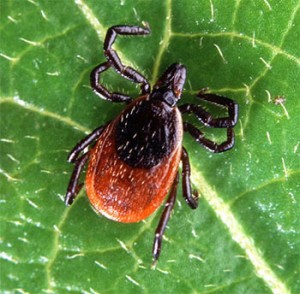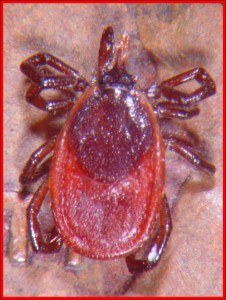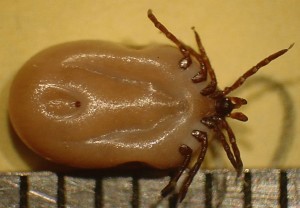
Deer Tick or Black-legged Tick
Deer Tick or Black-legged Tick (Ixodes scapularis)
The black-legged tick or deer tick, is the main vector of Lyme disease. Lyme disease symptoms, caused by coiled spirochete bacteria (Borrelia burgdorferi), develop within 3 to 32 days and include an initial reddish skin rash at the tick bite site, commonly expanding to many inches in diameter and appearing like a ring or bull’s-eye. The rash fades, with or without treatment, after a few weeks (not all infected people develop this rash). Early symptoms include flu-like chills, fever, headache, dizziness, fatigue, joint ache, and a stiff neck. Subsequent symptom progression involves swelling and pain in the joints, especially the knees that can lead to chronic arthritis, sometimes a year after the bite. Less common symptoms include heart arrhythmia, weakness in legs, facial paralysis, and numbness. Antibiotic therapy is most successful when treatments begin during early stages of the disease development.
Life Cycle and Habits
The black-legged tick in the eastern United States is a three-host tick that has a two-year life cycle. Eggs deposited in the spring hatch into six-legged larval ticks (most occur in late summer), which attach to small mammals (white-footed mouse, voles, chipmunks) or birds to obtain their first blood meal. These larvae overwinter, then molt to an eight-legged nymphal stage. Nymphs attach to small to medium size animals (mice, dogs, raccoons, possums, gray squirrels) and humans. It is this small nymphal stage that transmits the Lyme disease agent to humans. Nymphs molt to the adult stage the same summer, and then crawl to a large mammal, most commonly white-tailed deer. After engorging, they mate on or off the host and later lay eggs. They are commonly found in and near wooded areas.
Lyme Disease History
The disease was first identified in Lyme, Connecticut in 1975 with the heaviest concentrations now recognized in the Northeast, upper Midwest, and along the northern West coast. Eight states have recorded the highest numbers of cases. These are Pennsylvania, New York, New Jersey, Wisconsin, Minnesota, Massachusetts, Connecticut, and Rhode Island. About 10,000 human cases are diagnosed annually. Lyme disease is also found abroad in Germany and Scandinavia, as well as China, and Asia to Australia.
Migratory birds may partially account for the spread of this disease since larval and nymphal black-legged ticks often feed on ground-feeding birds. The active months for human infection are May to August. Peak months are June and July.
Lyme disease symptoms resemble many other diseases, like spirochete-caused syphilis. Lyme disease has been called the ‘great imitator’ since blood tests do not always confirm Lyme disease or rule it out. Lyme disease long-term effects can be arthritis, facial paralysis, meningitis, abnormal heartbeat, myocarditis, depression, memory loss, numbness, and impaired hearing and vision. Lyme is not usually a fatal disease, but can be debilitating, emotionally as well as physically. Unfortunately, vaccines for people won’t be on the market for some time. A vaccine for dogs is available.
Modified from the Ohio State University Extension Fact Sheet Black-Legged Tick HYG-2147-98 by William F. Lyon, Richard L. Berry and Robert A. Restifo. OSU Entomology – 1991 Kenny Road, Columbus, Ohio 43210-1090






 Print
Print Email
Email




